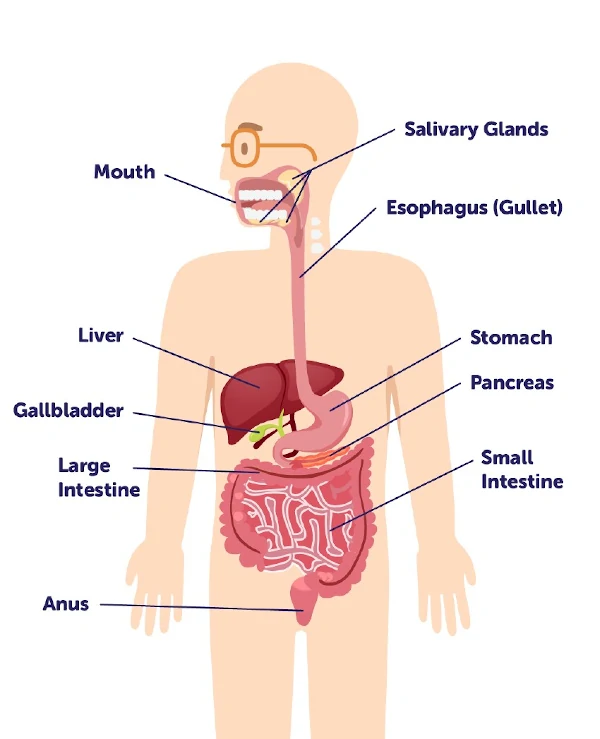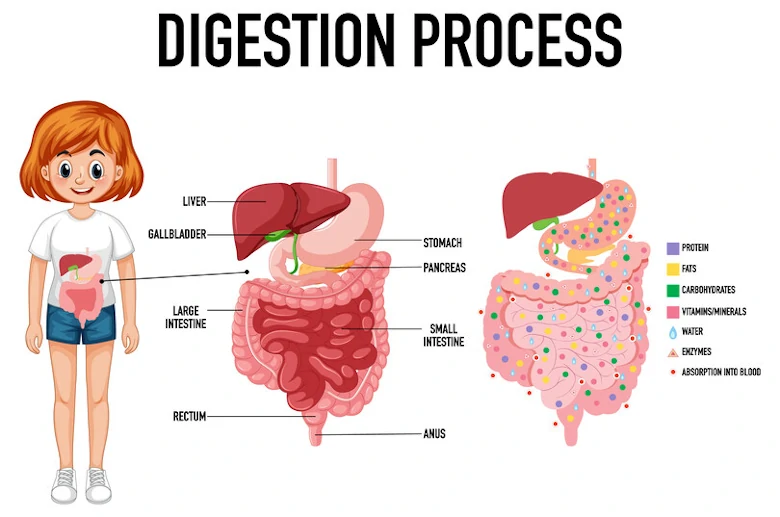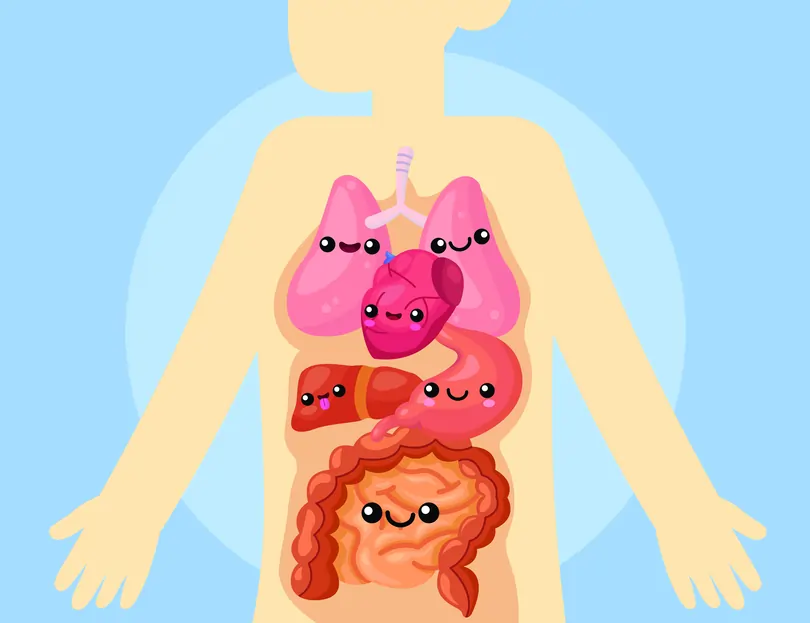Digestive System

In this article, you will be introduced to the human digestive system according to the Singapore Primary 3 Science syllabus. We will focus on the parts of the human digestive system and their respective functions.
Human Digestive System
The human digestive system is made up of the mouth, gullet, stomach, small intestine, large intestine and anus. These are called Digestive Organs and the main function of the human digestive system organ is to break down (digest) food into simpler substances for the body to absorb and use.
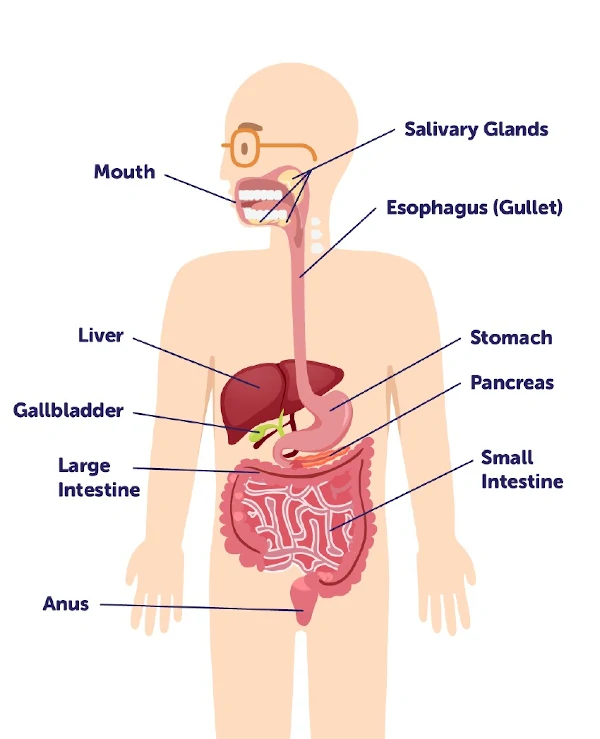
Mouth
The mouth is where food enters the human body. The mouth consists of the tongue, teeth and salivary glands that produce saliva. Digestion starts in the mouth as there are digestive juices in the saliva. The teeth help to break down food into smaller pieces, which increases the surface area of the food exposed to the digestive juices for digestion to take place faster.
Gullet
The gullet (also known as the esophagus) is a muscular tube that connects the mouth to the stomach. It helps to transport (partially digested) food from the mouth to the stomach. The muscular contractions and relaxations of the gullet help to push the food down. No digestion takes place in the gullet as there are no digestive juices produced in the gullet.
Stomach
The stomach is a muscular bag-like organ with its lining coated with mucus. The stomach produces gastric juices which consist of digestive juices and stomach acid. The mucus on the stomach lining helps to protect the stomach from stomach acid. The digestive juices break down food into simpler substances while the stomach acid helps to kill germs and bacteria in the food.
Small Intestine
Partially digested food from the stomach will be pushed into the small intestine. The small intestine is where most of the food is being digested and digestion ends in the small intestine. Digested food will be then absorbed into the bloodstream through the walls of the small intestine and the circulatory system will transport the digested food to all parts of the body. The remaining undigested food will be pushed towards the large intestine.
Large Intestine
The function of the large intestine is to remove excess (remaining) water from the undigested food. Then, the undigested food will be passed out from the body through the anus as faeces. When the large intestine does not function properly, the faeces will be watery as the excess water is not removed from the undigested food. However, if the undigested food remains in the large intestine for too long, too much excess water will be removed and the faeces will become hard and dry.
Watch our video lesson!
Note: This video lesson on Digestive System is just one of the many weekly GenieClass lessons you can attend from the comfort of your home. If you prefer learning in a physical classroom, check out our new tech-enhanced tuition classes at Geniebook CAMPUS.
Conclusion
In this article, we learnt that the human digestive system is made up of the mouth, gullet, stomach, small intestine, large intestine and anus. We also learnt about the functions of each of the parts in the human digestive system.
Test Your Concepts
Answer the following questions based on the concepts that we have covered in this article. If you are unclear, you may want to revisit the relevant section to revise the concepts.
Question 1:
The graphs below show the changes in the amount of three different types of food in our digestive system at the start and at the end after 5 hours.

Based on the information given in the graphs, which type of food, E, F or G, is the easiest to digest? Explain your answer.
Solution:
Food E is the easiest to digest. There is the least amount of Food E left after 5 hours, which shows that Food E was being digested the fastest.
Explanation:
Based on the graph, there is the least amount of Food E left after 5 hours. This shows that Food E was digested at the fastest rate within the same amount of time as compared to foods F and G.
Click here to read fun facts about digestion next!
| Continue Learning | |
|---|---|
| Systems | Diversity Of Materials |
| Plants And Their Parts | Living And Non-Living Things |
| Diversity Of Plants | Digestive System |
| Diversity Of Animals | Fungi & Bacteria |
Test Yourself
The diagram below shows the human digestive system.
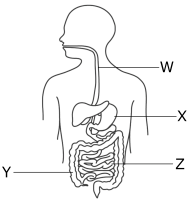
Which of the following parts produce digestive juices?
W is the gullet, X is the stomach, Y is the large intestine and Z is the small intestine. Digestive juices are produced in the stomach and small intestine while no digestive juices are produced in the gullet and the large intestine.
Flowchart illustrates food's journey in the digestive system.
mouth → A → stomach → B → C
Identify A, B, and C correctly?
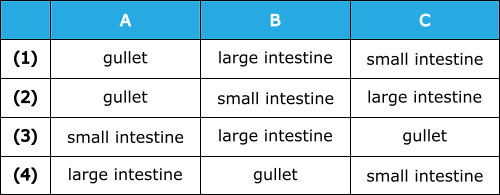
The food consumed will travel from the mouth to the gullet, followed by the stomach and the small intestine and lastly, the large intestine.
Which one of the following shows the correct flow on how food is digested in a digestive system?
1. mouth → gullet → stomach → large intestine → small intestine → anus
2. mouth → gullet → small intestine → stomach → small intestine → anus
3. mouth → gullet → large intestine → stomach → small intestine → anus
4. mouth → gullet → stomach → small intestine → large intestine → anus
The alimentary canal starts with the mouth, through the gullet, stomach, small intestine and large intestine before excreted through the anus.
The walls of the gullet, stomach and small intestine are muscular. Which of following statements describe(s) the functions of these muscles?
A: The muscular walls of the gullet help to move food along the digestive system.
B: The muscular stomach help to churn and mix the digestive juices with the food.
C: The muscles break down the food into simpler substances.
Choose the correct statements
The muscles in the gullet push the food down to the stomach and the muscles in the stomach helps to churn the food.
What will happen if the small intestine does not function properly?
1: Food will not be able to reach the stomach.
2: Energy cannot be released by the body.
3: The body will not be able to absorb water from food.
4: Digested food cannot be absorbed by our body.
Small intestine is where last stage of digestion occurs and the digested food will be absorbed into the bloodstream.




 SG
SG  VN
VN 
